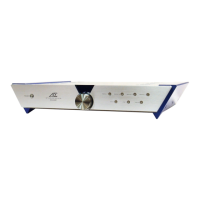SM-SX100
– 15 –
2-2) 7th order modulation circuit and devising
If any 1-bit signal is produced through the operation of the modulation, the quantized noise is expelled to the high range.
This is well known as "noise shaping", and it is used to reduce the quantized noise of the target frequency band (example:
audible band). As the operation of "primary modulation" is described using Fig. 15-1, it is well known that the reduction
effect of the quantized noise is increased as the number of the order of the modulation is increased.
Quantized noise
Audible band
0
fs/6
Frequency
7th order
5th order
3th order
0th order
Figure 15-1 NUMBER OF ORDER, AND NOISE SHAPING
The circuit here used to produce the 1-bit signal is practiced of "7th order modulation algorithm" as shown in Fig. 15-
2.
The strong noise shaping is applied to assure the wide dynamic range in the audible range.
Figure 15-2 7TH ORDER MODULATION ALGORITHM
Q
Q
Z
–1
Z
–1
Z
–1
Z
–1
Z
–1
Y
Output
Quantization
Adder Integrator Multiplier
Delay unit
Quantizer (–1 or +1)
Input
X
a
1
b
1
a
2
a
3
b
2
a
4
a
5
a
6
b
3
"7th order modulation LSI" gained by integrating the signal process circuit into one chip is shown in Fig. 15-3. As well
as the LSI can independently generate the 1-bit signals, the input terminal is provided to apply the feedback of the
modulation from the external in order to show the performance with the amplifying operation.
Figure 15-3 7TH ORDER MODULATION 1-CHIP LSI

